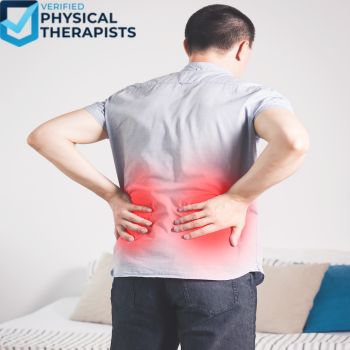
Physical Therapy for Herniated Discs: Exercises & Healing
Effective recovery from spinal disc herniation often entails a comprehensive method aimed at restoring mobility and health. Comprehensive physical therapy plays a vital role in alleviating discomfort linked to these challenges. Targeted exercise routines are designed to ease pain while enhancing strength and flexibility. Individuals may experience sharp discomfort, numbness, or weakness as common signs and symptoms of this condition. By prioritizing core stability and increased flexibility, treatment improves recovery results. Personalized exercise regimens created by a qualified therapist can significantly alleviate pain associated with herniated discs and enhance overall physical function through targeted physical therapy techniques.
Understanding Herniated Discs
Back discomfort can significantly affect a person’s quality of life, often stemming from issues related to the spinal structure. In particular, when the inner tissue of an intervertebral disc pushes through its outer layer, it can lead to serious complications. This condition frequently results from pressure due to age-related degeneration, injuries, or the strain of lifting heavy objects. Over time, wear and inflammation can weaken the disc, causing it to impact nearby nerves, which may manifest as radiating pain or muscle weakness. Proper diagnosis through methods like MRI and CT scans is crucial for assessing nerve root involvement and planning treatment. Early consultation with a physician can not only halt the progression of the disease, but also provide effective treatment options such as medication, physical therapy, or even surgical interventions like discectomy or spinal fusion to alleviate pressure on the lumbar vertebrae and reduce inflammation affecting the nerve roots, ultimately improving the patient’s quality of life and reducing the risk of disability.
Effective Exercises For Pain Relief
Maintaining an active lifestyle can be a crucial factor in managing discomfort and enhancing overall well-being. Incorporating targeted exercises into your routine can significantly aid in pain management, particularly for those dealing with conditions such as degenerative disc disease. Regular movements help alleviate discomfort caused by muscle strain and promote flexibility through gentle stretching exercises. Strengthening exercises enhance muscle support around the vertebra, while low-impact cardio activities like walking or swimming boost circulation without stressing the body. Prioritizing safety is essential; always perform warm-up and cool-down routines to avoid injury. Listen to your body, adjusting your pace as needed to prevent injuries. Consistency is key for effectiveness, so set a realistic schedule to track progress and reinforce your commitment to managing discomfort.
Active Lifestyle and Pain Management
- Regular exercise can reduce the perception of pain and improve the quality of life for individuals with chronic conditions.
- Targeted strengthening exercises can provide better support for the spine, potentially reducing the progression of degenerative disc disease.
- Low-impact cardio activities, such as walking or swimming, have been shown to enhance blood flow and promote healing without causing additional strain on the body.
- Incorporating a consistent warm-up and cool-down routine can decrease the risk of injury and improve overall exercise effectiveness.
Importance Of Physical Therapy
Rehabilitation is essential for individuals recovering from injuries or managing chronic conditions, as it fosters recovery and rejuvenation. Engaging in targeted exercise not only enhances flexibility but also strengthens the body, enabling a more effective comeback. A skilled therapist examines each patient’s needs, crafting personalized plans to address specific challenges like herniated disks or back pain. This approach not only aids in immediate recovery but also prioritizes long-term outcomes, ensuring a sustainable path to wellness. Regular involvement in therapy can significantly reduce the risk of future injuries while contributing to improved functionality. Many individuals find lasting relief from pain, ultimately enhancing their mobility and overall quality of life. Effective physical therapy and exercise can help strengthen the spine and alleviate back pain caused by conditions such as herniated discs and peripheral neuropathy.
Signs And Symptoms To Watch For
Being aware of specific indicators can greatly enhance the effectiveness of interventions. Localized pain in the lumbar region often serves as an initial sign of potential complications, such as an intervertebral disc issue. Numbness or tingling sensations may accompany this discomfort, underscoring the necessity for a thorough assessment. Alterations in reflex responses or limited mobility are critical signs that may indicate a worsening condition requiring timely rehabilitation. Monitoring behavioral changes, such as increased anxiety, is essential, as they can influence pain management techniques. Promptly seeking professional assistance can lead to an appropriate treatment plan, including options for therapeutic physical therapy for herniated discs, injections for pain relief, and strategies to manage pain and numbness associated with lumbar disc herniation.
Lumbar Disc Issues
- Localized pain in the lumbar region is often the first sign of intervertebral disc problems.
- Numbness or tingling can indicate nerve involvement and requires immediate evaluation.
- Changes in reflexes or mobility may signal a deterioration in condition that needs urgent rehabilitation.
- Behavioral changes, like increased anxiety, can affect the effectiveness of pain management strategies.
How Therapy Techniques Aid Recovery
Individuals facing challenges related to pain and mobility can find significant benefits through a range of supportive methods. Techniques aimed at treating a herniated disc not only focus on alleviating discomfort but also play a crucial role in enhancing overall well-being. Manual therapy is one effective approach that utilizes hands-on manipulation to help reduce inflammation and improve circulation. This method can facilitate recovery by addressing specific areas of concern. Incorporating targeted exercises is essential for strengthening muscles and bolstering spinal support. Engaging in physical activity helps those dealing with low back pain to regain strength and flexibility, promoting a healthier lifestyle. Consistent movement and rehabilitation are vital components in overcoming challenges related to a herniated spinal disc, as they can help reduce inflammation, relieve pain, and restore physical activity through targeted treatments and exercises guided by a physical therapist.
Managing Pain With Conservative Treatments
Exploring avenues that do not require surgery can lead to effective solutions for alleviating discomfort. Various non-invasive options exist, combining innovative therapy techniques with lifestyle modifications aimed at enhancing well-being. Engaging in a targeted physical therapy program can strengthen back muscles while improving overall functionality. Notably, techniques like cold therapy and specific exercises can address conditions that contribute to discomfort, such as a herniated disc. This approach not only helps decrease pain but also fosters mobility and resilience. Implementing ergonomic adjustments and effective stress management strategies is essential to support lasting recovery. Regular assessments of progress are vital to ensure that treatment plans are tailored, promoting continuous improvement and helping to alleviate pain and prevent future injuries.
| Non-Invasive Solutions | Benefits |
|---|---|
| Physical Therapy Programs | Strengthens back muscles and improves functionality |
| Cold Therapy | Addresses conditions like herniated discs and decreases pain |
| Ergonomic Adjustments | Supports lasting recovery and enhances mobility |
| Stress Management Strategies | Essential for promoting continuous improvement |
The Benefits Of Strengthening Back Muscles
Maintaining strong muscles in the back is vital for preventing discomfort and ensuring optimal mobility throughout daily activities. When muscle strength is lacking, individuals may experience issues such as pain may, leading to conditions like a herniated disc. Enhanced stability of the spine is achieved with robust musculature, significantly minimizing the risk of injuries. Many people experience a herniated disc seeking temporary relief through pain relievers, rather than addressing the root cause of their discomfort. Incorporating specific exercises not only improves posture but also aids in functional movement. For those affected by neck pain or lumbar intervertebral disc herniation, physical therapy plays a crucial role in helping to stabilize the spine and ease pain through personalized treatment plans designed to address the specific needs of the patient.
Personalized Approaches To Rehabilitation
Effective recovery hinges on understanding and addressing the unique needs of each patient. Tailored rehabilitation plans not only accommodate individual circumstances but also significantly enhance the journey toward healing. Regular assessments are critical in tracking progress, as they help determine the best course of action for those affected by conditions, including a lumbar herniated disc. Such an approach allows healthcare providers to refine strategies continually, ensuring that therapy can significantly contribute to overall improvement. Integrating patient feedback is essential as it fosters engagement and promotes adherence, ultimately leading to successful outcomes in treatments for herniated discs.
Tailored Rehabilitation
- Personalized rehabilitation plans improve patient outcomes by addressing specific needs.
- Regular assessments are crucial for monitoring progress and adjusting treatment strategies.
- Incorporating patient feedback enhances engagement and adherence to treatment plans.
- Effective therapy for conditions like lumbar herniated discs can lead to significant overall improvement.

